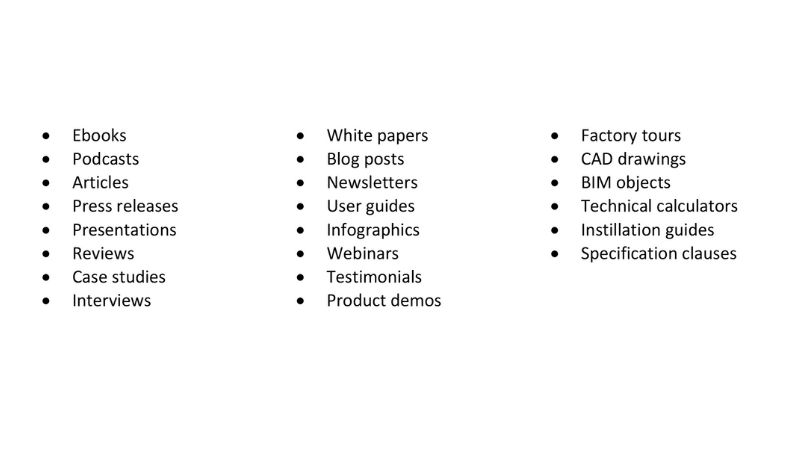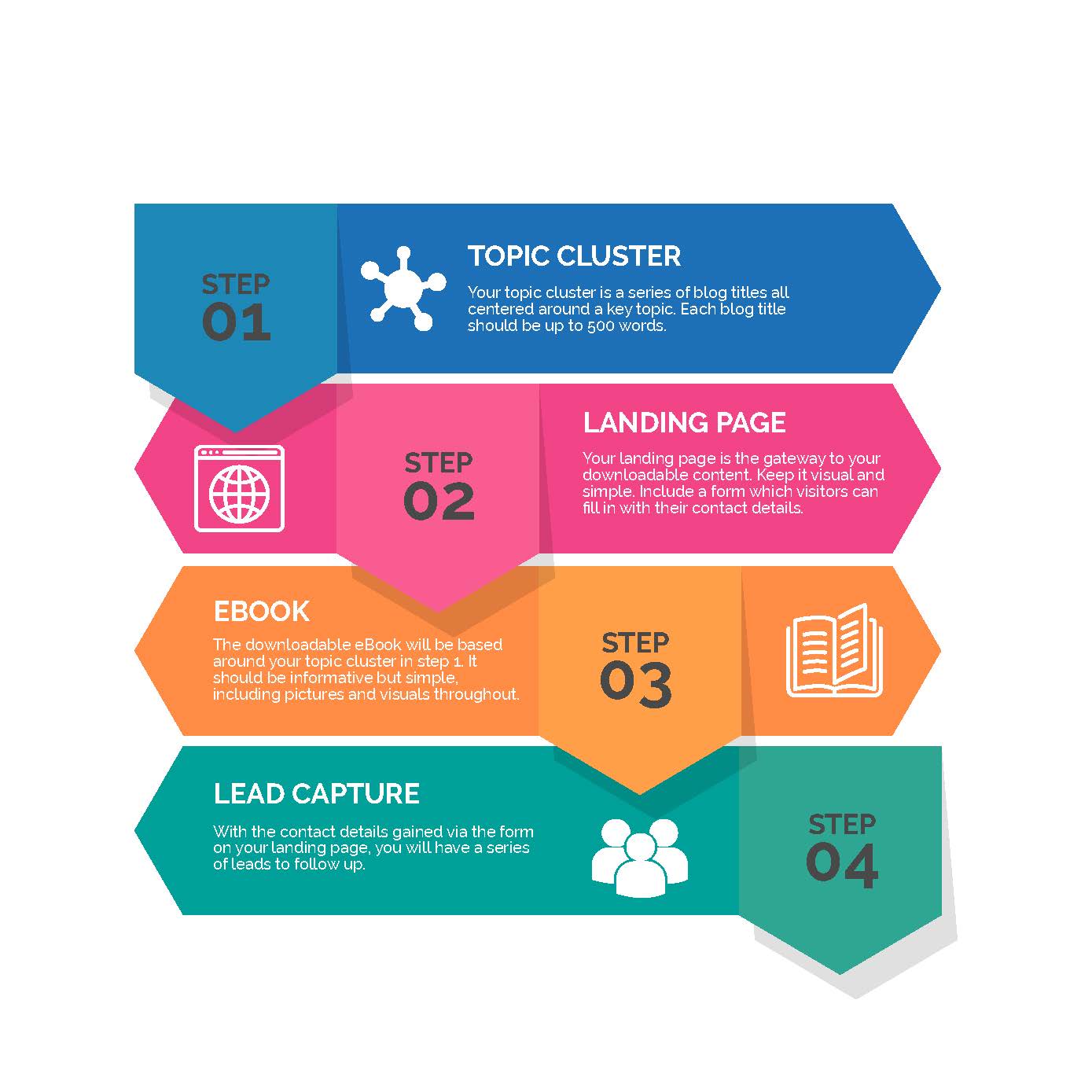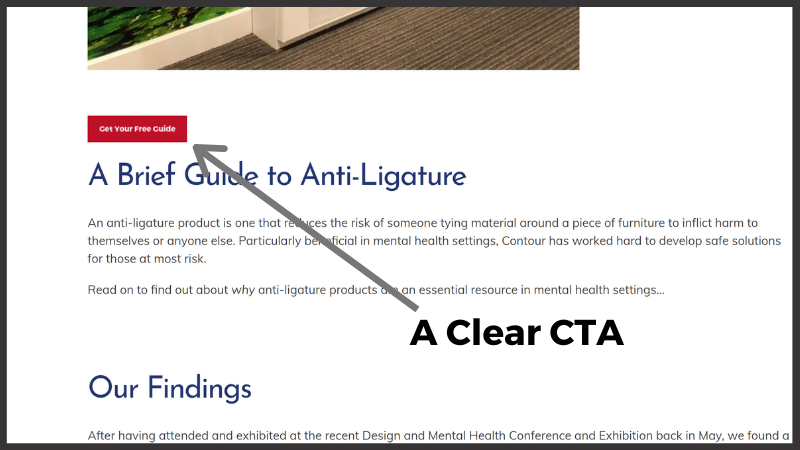
.png?width=1320&name=What%20Is%20Content%20Marketing%20For%20Construction_%20(1).png)
In this post, we’ll aim to cover all aspects of content marketing for construction and how it can prove to be a profitable, results-driven tactic-not to be ignored in today’s digital world.
Why Is Content Marketing For Construction Important?
The more structured content you have, the more likely you are to rank highly in Google’s search results. This increases the number of visitors (traffic) you’ll receive on your website.
Aside from your Google ranking, effective content can provide answers to common queries-with the solutions you provide. It can also establish you as a thought-leader in your field; a fountain of knowledge that sets you apart from your competitors.
Are Building Products Businesses Failing At Construction Content Marketing?
Many building products and construction businesses are still in their infancy when it comes to content marketing. Some rely heavily on word-of-mouth; some rely on traditional sales and marketing approaches to gain business, such as trade shows, advertising and cold calling.
The small amount of blogs that we do see are usually sporadic, inconsistent and not optimised for Google search.
By incorporating modern marketing methods-aimed at the modern searching habits of people today-you’re on your way to gaining the specifiers and customers you really want and growing your business in a sustainable and consistent way.
Different Types Of Construction Content Marketing
You’re in the fortunate position of having a wealth of content options at your fingertips. You may not know it, but building products and construction is an industry that relies heavily on content.
So, let’s look at the different types of content that you could be producing and making available to your customers and specifiers.

Don’t be alarmed by this list. You’ll find that you already have a number of these options available on your website.
In this post, we’ll be focusing on blogs. Creating blogs can be one of the most effective ways of driving traffic and generating leads, yet many building product and construction companies don’t quite use it to its fullest potential.
Use this post as a guide. We’re going to explore every element of content marketing for construction in a clear and systematic way, so that you can reap the benefits… and obtain the all-important metrics to prove just how effective blogging can be.
Read our case study on how Insynth delivered major growth through content marketing.
Generating Construction Content Marketing Ideas
You can’t (and shouldn’t be expected to) pluck ideas out of thin air. This expectation would be both unobtainable and unrealistic. That’s why you need to consider a way to generate ideas that work for the benefit of you and your company.
How Do You Generate Ideas For Construction Content Creation?
The easiest and most straight forward way to generate ideas for content is by answering your customers’ questions.
For example, if you have a query you get asked regularly, then use the question as your blog title and create the content for your blog with the answer.
Also, consider the phrases and keywords that your potential customers are using online to find solutions like yours-and the words you use to discover your competitors. This approach will dictate your SEO strategy.
Getting Your Keyword Research Right
Keyword research tells you what topics people care about and how popular these topics are among your audience. This information can be found with an effective SEO tool.
Using a tool will inform you of what keywords are getting a high volume of searches per month. This valuable information can then be used to inform your content strategy.
Through keyword research, you’re beginning to tackle the questions that the most people in your space want answers to. It’s a great way to find out word popularity, search volume and general intent.
Topic Clusters For Your Construction Content
Once you’ve got an understanding of the keywords that your audience is using to find products like yours, you can begin by creating a topic cluster.
Let’s say that you’re an acoustics consultancy that provides acoustic solutions for a range of purposes. In your keyword research you found that the term, ‘office acoustics’ generates a high number of searches a month. Therefore, it would be wise to base your topic cluster around ‘office acoustics’.
Armed with your keyword (office acoustics), you’ll then decide on around twelve blog titles based around office acoustics. They could be ‘How Office Acoustics Affect Productivity’ or ‘Cost-Effective Ways To Improve Office Acoustics’.
Is It Just About Writing Blogs?
Your blogs should be centred around a ‘pillar post’, which is normally a 2000+ word blog based on all the blogs from your series.
You should always aim to produce an eBook off the back of your blog series, too. This could be made available through an offer on your site. Visitors could download it in exchange for their email address. These contact details could then be forwarded onto your sales team.

Planning A Framework For Construction Content Marketing
Having a repeatable, organised and agile framework will make this process of creating content smooth and rewarding.
We understand the need for creating content on a large scale and you simply don’t have the time to constantly reinvent the wheel. That’s why having a clear and repeatable process in place that allows you to produce blogs, case studies, interviews, etc will make your job much more efficient.
The key message here is the importance of organisation and having your sights firmly set on that end goal.
Step 1: Set Timelines
Once you have generated some ideas, start planning your timeline. When and how often will your content be distributed? We recommend not planning more than three months ahead. That’s because things change over time, hence the importance of having an agile and adaptable framework.
Step 2: Create A Workflow
A workflow will clearly outline who’s going to be doing what tasks. This will ensure that work is evenly distributed, and insights are taken from a range of people from different departments. We recommend a workflow with all our clients as it clearly highlights our role in your content process, too.
Tell A Story For Your Construction Content
Content marketing for construction-like any content marketing-requires you to tell a story. If your content doesn’t tell a story, no one will want to read it and the key to successful content is keeping your audience engaged.
It’s not just a case of simply typing out what comes into your head. You may be an expert on your product, but you have to consider how this will resonate with your audience.
Will it engage your readers, or will it come across too ‘wordy’ and, thus, confuse them? This is why storytelling plays such a big role in your content creation strategy.
Everyone loves a good story. Stories have a unique way of influencing, inspiring and teaching readers all at the same time.
Stories connect people through ideas. Stories unite people through a conviction of culture, history, and values.
The same is true in business. Telling stories is about connecting your business with your prospects and customers.
Characters, Conflict and Resolution
Every story has these three main elements. In your building products company, the character is the reader (i.e. your architect or specifier). The conflict is the problem your reader faces; the whole reason they came across your article in the first place. Your primary aim here is to provide answers, relieve stress and make lives easier.
Where there is a problem, there has to be a resolution. At this stage, you should be asking yourself ‘How did the characters change?’ and ‘What happens next?’
You should be providing your readers with a ‘next step’. This could be a ‘call to action’ to some additional content on your website, or even a form to fill in which allows readers to download an offer.
The revenue you’ll gain from this will be a well-structured business plan and customers who believe in what you do.
Calls To Action For Your Construction Content
‘Your Reader Has Read Your Blog. They’re Impressed By It, What Next?’
This is where a relevant call-to-action is required. You want to tell them what to do next. This could take on many forms, for example, ask the reader to like/comment/share, subscribe to your newsletter or download a piece of related content to take away with them.
We often create buttons that can be embedded at least twice throughout your blog. Here are a few examples:

CTAs can take on many forms. Above, I have just given a few examples. Notice how the button on each CTA is clear to see?
Your blog should always direct the reader towards a ‘next step’. It’s your opportunity to:
- Impress them further with a free offer
- Encourage readers to engage with your brand further
- Drive them towards a profitable action
CTA Best Practice
When you’ve completed your topic cluster of around 8-12 blogs, you’ll start your pillar post, and eventually an eBook. When your eBook is complete, we advise you to create a CTA to download the free eBook. You’ll then want to update your blogs with this new CTA.

Improving Your Construction Content Writing
Getting words down on the page is step one. Getting your work published is a different matter.
Quite often, your first draft will look largely different to your final piece. During the editing and improving phase, you’ll be using it as an opportunity to cut out any unnecessary and irrelevant points that don’t support your core ideas and refine your language to be stronger and more action orientated.
10 Common Grammar And Style Points
1: Use Contractions
Contractions are when you join two words together with an apostrophe, for example, do not = don’t, have not = haven’t, etc.
Your aim is to connect with your reader on a human level.
By using contractions, you are adding to a conversational tone, allowing yourself to be approachable.
2. Simple Language
No one likes to slug through overly complex writing full of unfamiliar words. By simplifying your language, it makes it easier for the reader to process.
This doesn’t mean dumbing down your writing. You can write smart by using simple words. To take a famous quote by Albert Einstein:
“If you can’t explain it simply, then you don’t understand it well enough.”
3. Clear And Concise
By keeping your writing clear and concise, there’s little chance for confusion or misinterpretation. Focusing on too many topics or keywords at once could work against you as Google will struggle to decide which content is relevant for which keywords.
4. Short Sentences and Paragraphs
Break up your long, dense sentences and paragraphs to make your content easier to read and comprehend.
Not only are shorter sentences easier for your audience to read, but they’re preferred by Google when it comes to SEO.
5. Use White Space
Properly using whitespace between paragraphs and in the left and right margins can increase comprehension up to 20%. Don’t say something for the sake of it, say it because it adds value.
You should embrace white space rather than try to fill it. White space can be vital in controlling where your audience look next and how to draw focus in on important points.
6. Cut Out Fluffy Words
When I talk about ‘fluffy words’, I am referring to words such as:
really, actually, just, incredibly
These words can make sentences and phrases bloated, which is unnecessary. Too many adverbs (words ending in ‘ly’) or adjectives also make sentences overly long and complex.
7. Use ‘You’ And ‘Your’
When writing your blog, you want to make sure that it comes across as though you’ve written it especially for your reader. By using ‘you’ and ‘your’ you make it more relatable to the reader, making the message personalised.
8. Avoid Jargon
As a building products and construction company, it will be necessary, at times, to use technical language, particularly if your target reader is an architect or specifier.
When used in an appropriate context, technical language helps you to communicate precisely with other specialists who possess the same level of expertise as your own.
Used inappropriately, however, jargon will make it harder for readers to perceive information.
9. Don’t Be Snarky
Critical and sarcastic writing might have its place in the world of content marketing, but for most building products and construction companies, this will come off negatively.
10. Use A Grammar Tool
Even the smallest error can have a negative effect on your readers’ perception of your brand. As a rule, I always do two things before I publish a blog article online:
- I use the ‘read aloud’ tool installed on Microsoft word.
- I run it through the Grammarly Google Chrome extension.
Promoting Your Content Marketing For Construction
Many building product companies turn to product directories to help promote their products. A building product directory is an online resource for building specifiers, such as architects and engineers.
Directories are used in up to 76% of product research in the UK so they should be used as important components of any marketing strategy.
There are many building product directories out there, so it’s important to sift through and find the ones that are A) appropriate to your offering, and B) reputable.
Many market themselves as product directories, but in reality, are trade listing or business listing sites. Whilst these sites provide a backlink to your website, increasing potential referral traffic, they don’t offer much in the way of assistance to specifiers who are looking for solutions.
Below is a list of product directories that are widely used by specifiers:
Whilst building product directories are an important consideration for content promotion, Google will always be the primary choice for search, which is why it’s important that your website is optimised for search and delivers the right content for your audience.
Promotion Via The Trade Press
Trade magazines are widely used by architects and specifiers and are another way to share your content on a different platform. It’s a sure-fire way to ensure that your content is seen by the right people. Whether it’s a press release or a featured article, content promotion via trade press is an excellent way to acquire backlinks, which boosts your domain authority.
When speaking with magazine sales reps, always aim to get the best deal possible. What else could be included in the price? Try and get some social promotion thrown in, for example.
Download Your Free Guide To The Leading Architectural Magazines in 2019
Measuring And Analysing Construction Content
Managers want facts and figures. They want measurable and profitable results.
What evidence do you have that your construction content marketing efforts are successful? This information will allow you to see if the content you’ve invested so much time on producing is actually working, and most importantly, whether it’s driving sales.
- Brand Awareness. There are different ways that you can track brand awareness. You could measure reach on various channels such as social media followers.
You could also measure conversations about your brand, such as media and press coverage, or reviews online.
An effective way to track mentions of your brand online is to create a Google Alert for the name of your business. The service will send you an email when it finds new results-such as web pages, newspaper articles, and blogs-that match the user’s search term(s).
- Engagement. This will help you discover not only who’s seeing your content, but who’s interacting with it. Social media is an effective way of tracking engagement because you’re able to view likes, shares, comments, and retweets.
You can also measure engagement on your website. For example, who’s commenting on your blog and how many comments did it receive?
When you send out a content offer via email, do your recipients click and download the offer?
All of these engagement ‘signals’ help you to determine the most successful content pieces, topics, channels, and formats.
- Lead generation. Things you may consider measuring here are how many leads you generated, whether they’re blog subscribers or whether they downloaded a content offer. From this, you can measure what activities led to someone becoming a lead. Was it a specific piece of content, campaign or source?
- Customer conversion and sales. What is the total return on investment (ROI) for your content marketing efforts? You can track the quality of sales influenced by content marketing and compare it to cold sales to help prove the ROI. Do marketing qualified leads have a faster time to close than cold leads? Do they purchase more, and more often?
You can also discover what the ratio of leads to customers is. This information will allow you to understand where your strategy may be falling short.
- Customer loyalty and retention. Can you compare the lifetime value of a customer originally sourced by marketing to that of a sales-sourced customer?
How often do your customers buy from you? Are they recommending your business to friends or peers in their field?
- Website performance. If your website isn’t optimised for user experience, your content strategy will be pointless. Keep track of your website’s performance through traffic, unique visitors, and which sources of traffic are top performers for your business.
There are many sources where visitors could come from, like paid search, organic traffic, email marketing, and more.
Bounce rate is also an important metric to track because it is representative of how well your content is living up to your visitors’ expectations. The longer someone stays on your site, the more your search engine rankings will improve.
What Do You Do With Data Once You’ve Collected It?
Review and share it with key stakeholders in your building products and construction company. This may include your management team, all the way up to your managing director. If you’ve followed these steps, you’re sure to see results.
And please do let us know if you found any of this information useful!
Conclusion
Writing content takes time. To ensure that your time is put to good use, ensure that you follow the steps highlighted in this post.
Always aim to blog around a topic and work towards a downloadable piece of content (eBook or white paper). Visitors should be able to download this content in exchange for their contact details.
The three main aims of content are:
- To educate, inform or inspire your audience • Generate more leads • To drive traffic towards a profitable action
Always keep these three goals in mind.
If you would like any more information on how you can create a workable content strategy for your building products and construction company, get in touch today.
About Insynth
As the only HubSpot certified agency to major on construction marketing, we bring together construction marketing strategy, digital strategy, website design, SEO, content marketing, email marketing, sales automation, marketing automation and HubSpot CRM implementation to produce successful campaigns and great results for our clients.
Book Your Free Consultation Today

